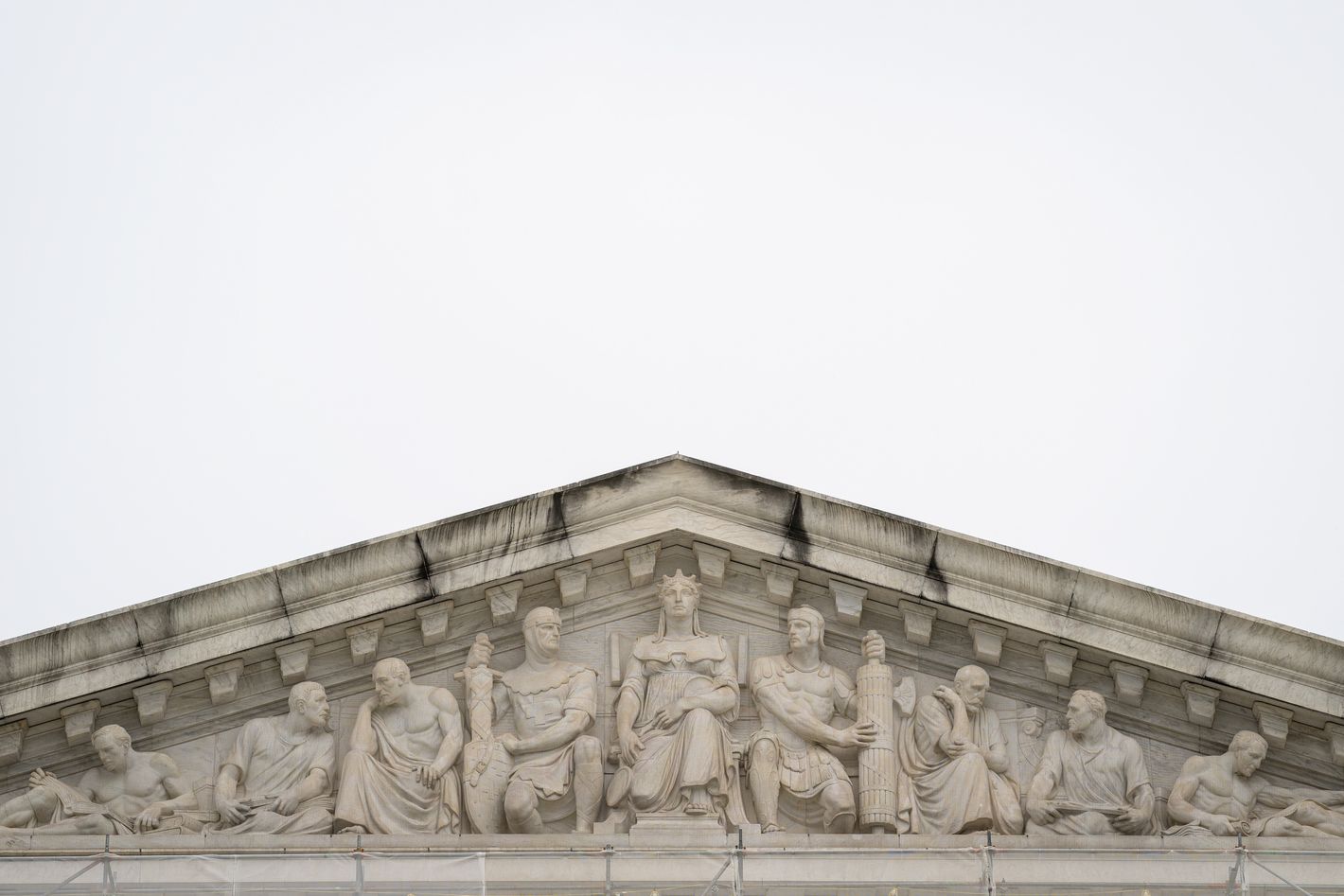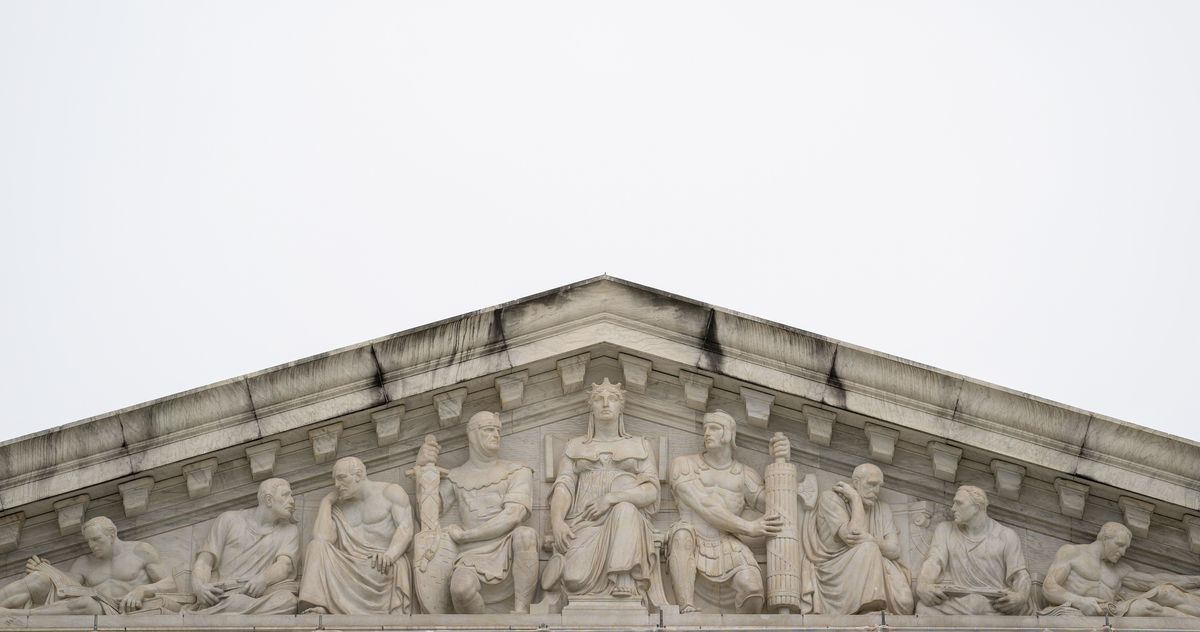 Photo: Graeme Sloan/Bloomberg via Getty Images
Photo: Graeme Sloan/Bloomberg via Getty Images
The U.S. Supreme Court’s monumental ruling on the Trump v. CASA birthright-citizenship case handed President Trump a victory, but the 6-3 decision wasn’t really about whether Trump could deny citizenship to the children of migrants but about federal judges’ ability to temporarily stop him on their own. What the Court’s conservative supermajority did was curb the power of federal judges to order nationwide injunctions against potentially illegal executive-branch actions, which is what the Trump administration’s lawyers wanted. In the aftermath, legal experts, pundits, and analysts have begun weighing in with their own thoughts, criticism, and fears. Below is some of what they’ve had to say.
A power grab that will protect Trump’s power grabs
Our own Ed Kilgore writes that “it is very clear that in this and other cases, the Supreme Court has enhanced its own power and Trump’s, as well, at the expense of lower-court judges and the aggrieved parties that rely on the judiciary to slow down the runaway freight train of the 47th presidency”:
The decision did not address the constitutionality of the administration’s demand for an end to birthright citizenship, the principle that anyone born is this country is entitled automatically to U.S. citizenship. Instead, the Court focused on the real goal of Trump’s lawyers in pushing this case: to rein in the many federal district court judges around the country who are trying to slow down the administration’s efforts to expand presidential authority, in cases ranging from deportations without hearings to mass firings of federal employees to usurpation of congressional spending authority. (Indeed, Barrett’s opinion noted that 25 nationwide injunctions were issued by district court judges in the first 100 days of the Trump administration.) This has often been a footrace between the administration and the judges, with the Supreme Court being the ultimate destination of an extraordinary number of legal disputes. Now the Court has given Team Trump a big advantage: Parties seeking judicial relief from executive-branch overreach will have to plod through multiple district courts or undertake the complicated process of putting together class-action suits. Many legal observers who might generally agree that individual judges have on occasion overreached their authority will be alarmed by the timing and practical implications of the decision, which is a precious gift to Trump’s lawyers.
But rather than viewing this as an emergency brought on by Trump’s power grabs, Barrett chose to view the situation as the result of a long, slow, and largely unwarranted expansion of the power of judges to issue injunctions, which the Supreme Court is finally and appropriately addressing. That it happened to benefit the power-hungry president who placed her on the Court was incidental.
Read the rest of Ed’s thoughts here.
The three loopholes left open
Politico details them:
Barrett’s 26-page opinion leaves a surprising degree of wiggle room. Yes, conventional nationwide injunctions are off the table, but Trump’s opponents say they see alternative routes to obtain effectively the same sweeping blocks of at least some policies that run afoul of the law and the Constitution.
The court appeared to leave open three specific alternatives: Restyle the legal challenges as class-action lawsuits; rely on state-led lawsuits to obtain broad judicial rulings; or challenge certain policies under a federal administrative law that authorizes courts to strike down the actions of executive branch agencies.
The viability of these three potential alternatives is not yet clear. But the court explicitly declined to rule them out. That led Justice Samuel Alito — who joined the majority opinion — to write a concurrence to raise concerns that the court was leaving loopholes that could undercut its main holding. If lower courts permit litigants to exploit those loopholes, Alito wrote, “today’s decision will be of little more than minor academic interest.”
Class actions won’t be the same
One of the groups fighting Trump’s birthright-citizenship order is already working to convert its lawsuit to a class action, but that won’t be an easier path. At The New Yorker, Ruth Marcus points out, as many others have, that Trump’s attempt to end birthright citizenship was never long for this world, legally, but she also explains that class actions won’t be a very good alternative for resolving these fights:
Justice Amy Coney Barrett, writing for the majority, ruled that courts must limit themselves to orders that deal with the disputes immediately before them; they may not rove beyond the case at hand to resolve issues for those who aren’t parties to it. At oral argument, Barrett had seemed to express some exasperation with the government’s position, so it was disappointing to see her in the majority. But Barrett left open the possibility that the states challenging the birthright order could prove they needed the broader relief of a blanket ban, leaving that question to lower courts to determine. She also suggested that those challenging Administration orders had another option: they could file their suits as class actions. This would be more comforting if the Court in recent years had not made it more difficult for plaintiffs to obtain class-action status and if the Solicitor General, D. John Sauer, had not said that the government would probably oppose granting class status, at least in the context of birthright citizenship. Then there is the concurring opinion in Friday’s case by Justice Samuel Alito, joined by Justice Clarence Thomas; they warned that “district courts should not view today’s decision as an invitation to certify nationwide classes without scrupulous adherence to the rigors” of its requirements. In other words, don’t count on class actions to rein in Administrations bent on abusing the law.
The Court’s suspicious timing
At Slate, Mark Joseph Stern warns that “at the worst possible time, in the worst possible case, SCOTUS has ceded immense power to a president who is dead set on abusing it:
For four years, the Supreme Court sat back as a hand-selected group of far-right judges issued a stream of universal injunctions against the Biden administration. Then, barely five months into Trump’s second term, it suddenly cut down the practice. The court has applied an egregious double standard that awards Republican presidents with sweeping authority and presumptive legitimacy while relentlessly curtailing executive power each time a Democrat occupies the Oval Office. No democracy can long survive a regime in which a monarchical president and his black-robed collaborators supplant the Constitution with their own partisan whims.
A complex new obstacle course for plaintiffs
At the Los Angeles Times, constitutional-law scholar Erwin Chemerinsky writes that “the practical consequences are enormous”:
It would mean that to challenge the constitutionality of a presidential action or federal law a separate lawsuit will need to be brought in all 94 federal districts. It means that the law often will be different depending on where a person lives. Astoundingly, it could mean that there could be two people born in identical circumstances in different federal districts and one would be a citizen, while the other would not. This makes no sense.
It will mean that the president can take an unconstitutional act and even after courts in some places strike it down, continue it elsewhere until all of the federal districts and all of the federal courts of appeals have invalidated it. In fact, the court said that a federal court can give relief only to the named plaintiff, which means that in the context of birthright citizenship each parent affected by the birthright citizenship executive order will need to sue separately. Never before has the Supreme Court imposed such restrictions on the ability of courts to provide relief against unconstitutional acts.
Will red and blue states now end up with separate federal laws?
That’s one of the possibilities The Bulwark’s Jonathan Last is worried about in light of the Court’s decision, which he believes will “set in motion a calamity”:
SCOTUS has empowered the president to impose whatever he likes — irrespective of its constitutionality — and then prevented judicial overview except at the localized level. Meaning that we will now have two sets of laws. One that operates in Red America and one that Operates in Blue America.
He offers some potential real-world implications as examples:
Let’s say two immigrants have a baby in Montana and no court in Montana has issued a stay against Trump’s EO. Does that baby have U.S. citizenship? No one knows.
Let’s say that Trump issues an executive order saying that registered Democrats cannot own firearms and that the government must merge the lists of party registration and firearms sales and confiscate guns owned by Democrats.
If a Massachusetts court issues a stay against this order, then a Democrat in Massachusetts will not have his gun taken from him. But if a court in, say, Idaho declines to issue a stay against it, then the policy can be put into place in Idaho up and until the Supreme Court finally rules against it.
The harms which can — which will — take place under this new legal regime are serious and the ability to remediate them will vary greatly. But the biggest harm is that the Supreme Court has made it even more important where you live. Because to live as a political minority now is to have your rights and liberties no longer safeguarded by the Constitution, but hostage to the most hostile reading of the law by the biggest hack judge in the neighborhood.
Democratic administrations stand to benefit, too
Vox’s Ian Millhiser emphasizes that national injunctions are a bipartisan concern:
During the Biden administration, MAGA-aligned federal judges in Texas routinely handed down nationwide injunctions on highly dubious grounds. Indeed, this practice so frustrated Biden’s Justice Department that, even after Trump won the 2024 election, Biden’s solicitor general, Elizabeth Prelogar, filed a brief asking the justices to limit their use.
The best argument against these broad orders is that they place too much power in individual judges, and in plaintiffs who can often shape which judge hears their case. As Justice Neil Gorsuch wrote in a 2020 opinion, “there are currently more than 1,000 active and senior district court judges.”In a world with nationwide injunctions, plaintiffs can shop around for the one judge in America who is most likely to be sympathetic to their cause, and potentially secure a court order that no other judge would hand down.
The most immediate beneficiary of Friday’s decision is Trump, who will now get some relief from nationwide injunctions. And it’s notable that the Republican-controlled Supreme Court waited until a Republican was in the White House before cracking down. Nevertheless, the decision in CASA should also benefit future Democratic administrations, assuming that the GOP-controlled Court applies it fairly to presidents of both parties.
The conservative majority has a hubris problem
At MSNBC, former federal prosecutor Shan Wu writes that Roberts and Kavanaugh center the Court’s supremacy in a way that’s totally detached from reality:
Kavanaugh says that in really important issues, it’s the traditional role of the Supreme Court to step in, thus reinforcing the diminishment of the role of lower courts. Implicit in Kavanaugh’s reasoning is the same arrogance that underlies Chief Justice Roberts’ view, namely that the justices are not only better at deciding important cases, but also should be the only ones deciding which are the important ones.
This view is startlingly myopic.
It’s myopic because issues like birthright citizenship are national by definition — they’re fundamental interpretations of the Constitution affecting all Americans. When they arise in a specific case, it’s critical that a lower court be able to freeze the status quo until there is enough time to fully litigate the issues. That’s exactly what an injunction does — it freezes the status quo to make sure irreparable harm doesn’t occur before the legality of the controversy can be properly litigated.
It’s also myopic because Roberts’ idea of speed is on Supreme Court time. Sure, taking a month to decide to hear a case and — in the case of birthright citizenship — another month or more to decide might be fast by high court standards, but in the real world it’s forever. Too much harm across the country can occur while Roberts and his fellow justices use their version of a “fast track.”
And finally, it’s also myopic because the overuse of the emergency docket shortcuts the full development of a legal case before it reaches the highest court in the land. The factual development accomplished through litigation and the appellate analysis of the trial court proceedings may all be jumped over. Often, the high court doesn’t even have oral argument on a case (although it did have it in this case), and typically the decisions are unsigned and can be quite brief in explaining the legal reasoning of a case.
Barrett’s opinion is an originalist fever dream
At Bloomberg, Noah Feldman explains why Justice Amy Coney Barrett’s “opinion itself is a classic example of the madness of originalism — the notion that the Constitution and US laws should be interpreted according to what they meant when enacted — not in light of contemporary reality”:
Barrett framed the issue in the case as whether the Judiciary Act of 1789 — one of the first laws passed by Congress after the ratification of the Constitution — would have allowed federal judges to issue universal injunctions at the time in light of English practice. She then asked if English courts of equity had any power analogous to the issuance of universal injunctions — and answered in the negative.
The first problem with this analysis is that the role of the judiciary and the realities of legal decision-making today are radically different from the circumstances of 1789. That’s true of the US — and even more true if the US is to be compared to 18th-century Britain.
The most crucial difference is that since 1803 and the famous Marbury v. Madisondecision, US courts have had the power to declare laws and executive actions unconstitutional, a power the English courts didn’t exercise and that wasn’t explicitly granted by the Constitution. When a court rules a law unconstitutional, there is no good reason for the executive branch to be able to implement it anywhere — a point emphasized by the two dissents in the case, one by Justice Sonia Sotomayor and the other by Justice Ketanji Brown Jackson.
Trump’s birthright citizenshipexecutive order is a perfect example. It’s obviously unconstitutional — as the dissenters stated and the majority didn’t deny. So why should the executive branch be able to enforce it anywhere once a court has ruled that it can’t be enforced within that court’s jurisdiction? Originalism misses the bus here because it ignores the evolution of the judicial power to allow the negation of unconstitutional laws and policies.
What happens next?
Former federal prosecutor Elie Honig agrees that the decision “alters the fundamental balance of power between the president and the judiciary” and though there’s no way to fully predict what “mayhem” that will prompt, he hazards some guesses:
I’d expect to see a rush to the courthouse doors as people who may be harmed by Trump’s policies come to realize that they cannot free-ride on broad-based judicial declarations in favor of other plaintiffs. The new rule, boiled down, is that courts can rule only as to the actual parties to any given lawsuit; if you want relief, your name needs to be on the case caption. (Relatedly, I’d expect to see a rash of class actions, which enable large groups of similarly situated plaintiffs to join the same lawsuit, though it’s often easier said than done, as judges apply exacting criteria before green-lighting such broad-based cases.)
The Court’s ruling will also ratchet up pressure on courts of appeals, including the Supreme Court itself, to consider cases with nationwide implications more quickly. As the dissenters note, certain issues demand uniformity. How can it be, for example, that a child born to noncitizen parents in one federal district might have different citizenship status than a child born under identical circumstances, only ten miles away, in another federal district? The issue demands a uniform nationwide resolution, and only the Supreme Court can provide such certainty and finality.
But while the decision is definitely a very big deal, Honig also throws cold water on the some of the more extreme fears about its impact:
While the Court’s decision is undoubtedly a landscape-shifter, some of the doomsaying is overblown. Justice Ketanji Brown Jackson warns in dissent that “if judges must allow the Executive to act unlawfully in some circumstances, as the Court concludes today, executive lawlessness will flourish, and from there, it is not difficult to predict how this all ends. Eventually, executive power will become completely uncontainable, and our beloved constitutional Republic will be no more.”
How, then, did we manage to survive as a nation for over 200 years until nationwide injunctions proliferated in the early 2000s? No doubt, our new legal reality will be confusing, and messy, and perplexing. The president and the presidency are now substantially more powerful than they were 24 hours ago. And while it’s the end of unilateral, nationwide exercises of power by district court judges, it’s not the end of the republic.
Read the rest of his analysis here.
Related
The Supreme Court Just Gave the President More PowerSupreme Court Curbs Judges’ Ability to Stop Trump Power GrabsSupreme Court Deals Blow to Public Schools and LGBTQ+ Rights
From Intelligencer - Daily News, Politics, Business, and Tech via this RSS feed


